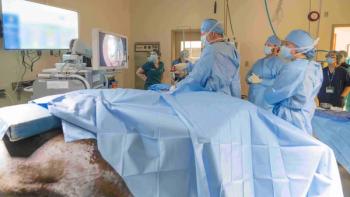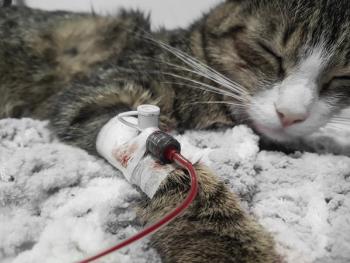
Surgical techniques for urinary incontinence (Proceedings)
Urinary incontinence is a relatively common problem in small animals with a variety of etiologies.
Urinary incontinence is a relatively common problem in small animals with a variety of etiologies. One of the more familiar and frustrating conditions is probably urethral sphincter mechanism incompetence (USMI) which most often occurs in adult spayed female dogs. Surgery is not the first or even second line of treatment for these animals. The first thing to do is to rule out other possible underlying conditions that would cause or contribute to urinary incontinence such as ectopic ureters, vaginal strictures, redundant epivulvar folds, chronic urinary tract infection, and neurological disorders. The second course of action is medical management primarily consisting estrogen therapy, phenylpropanolamine, or combination therapy. When dogs are unresponsive to medical treatment or if there are concurrent problems that limit the use of appropriate drugs, surgical intervention may be considered.
Aside from decreased resistance in the urethral sphincter mechanism, animals with USMI typically have other anatomical factors that may contribute to urinary incontinence, particularly a shorter functional urethra and intrapelvic positioning of the bladder. Therefore, the goal of most surgeries for urinary incontinence is to increase urethral sphincter resistance, increase the functional length of the urethra, or move the bladder and trigone into an intra-abdominal location.
Colposuspension
Colposuspension is the most common surgery used to address USMI in female dogs. This procedure involves placement of sutures from the cranial vagina to the prepubic tendon on either side of the proximal urethra, thereby positioning the proximal urethra within the abdomen and placing pressure on the urethra as it crosses the pubic brim. Several studies have looked the long-term outcome following colposuspension. One of the most recent studies reported a response rate of 82% with half of those animals completely continent without medication. These results are in contrast to a separate study which reported only a 54% response rate, although a client satisfaction rate of 86% was also found.
Prior to performing surgery, a large urethral catheter is placed. A caudal midline abdominal approach is performed and the vagina is identified dorsal to the urethra. Stay sutures or atraumatic forceps are used to manipulate the vagina cranially. Two sutures of heavy gauge (0 to 2-0) nonabsorbable monofilament are placed through the vaginal wall on either side of the urethra to the prepubic tendon on either side of midline. The urethral catheter is used to prevent overtightening of the sutures which may result in urethral obstruction.
Cystopexy
Cystopexy is a relatively simple procedure that involves permanently securing the urinary bladder in a more proximal direction. By fixing the bladder within the abdominal cavity, the trigone and proximal urethra are exposed to intra-abdominal pressure that may improve the tone of the upper urethral sphincter.
A routine caudal abdominal midline incision is made. There is usually no indication to perform a cystotomy. A stay suture is placed in the apex of the bladder to facilitate manipulation and positioning of the bladder. The bladder is positioned cranially in the abdomen without excessive tension. A #15 scalpel blade is used to gently scarify the ventral bladder wall for most of the length of the body. An area of similar size is created on the ventral body wall just to the right or left of midline. It is not recommended to incorporate the bladder wall in the abdominal wall closure. One or two rows of suture with a simple continuous pattern using 3-0 or 4-0 monofilament, absorbable suture are placed to fix the bladder to the body wall. Suture should be placed partial-thickness into the bladder, but absorbable suture is used in case of inadvertent luminal penetration. Following removal of the stay suture, the abdominal wall, subcutaneous tissue, and skin are closed routinely.
Fixation of the deferent ducts (deferentopexy)
For male dogs with urinary incontinence, cystopexy can be performed by using the ductus deferens. This technique can be easily performed in neutered dogs, but it requires castration for intact dogs. I most commonly perform this procedure in male dogs with perineal hernias to prevent bladder retroflexion, but fixation of the deferent ducts has been shown to result in good to excellent results in 6 of 7 incontinent male dogs.
Following a routine caudal abdominal incision, the each ductus deferens is located dorsal the trigone of the bladder. They can be easily distinguished from the ureters as they are freely movable and travel toward the inguinal rings. Each ductus is transected at the level of the inguinal ring. If castration has been performed at the same time, often the entire pedicle can be gently retracted into the abdominal cavity. Once the ductus had been isolated, it is pulled gently in a cranial direction until a small amount of tension is generated on the trigone and proximal urethra. At this level two small transverse incisions approximately 1 cm apart are made in the transversus abdominus muscle. The ductus is fed through these incisions and then folded back on itself in a "belt-loop" type fashion. Several simple interrupted sutures of 4-0 monofilament nonabsorbable material are used to suture the end of the ductus to itself. This procedure is repeated on the other side creating a gentle and even cranial pull of the trigone and proximal urethra. The abdominal incision is closed routinely.
Urethropexy
This procedure is typically performed in conjunction with cystopexy. The rationale behind urethropexy is similar to that for colposuspension and cystopexy, in such that the trigone is relocated to a more cranial intra-abdominal position. Urethropexy was performed on 100 dogs with USMI. A response rate of 83% was documented with 56% of dogs completely cured.
To perform this surgery, the largest urethral catheter that can be passed should be placed. A caudal abdominal midline approach is made exposing the pubic brim. A stay suture is placed in the apex of the urinary bladder facilitating cranial traction. The proximal urethra is identified. A suture of 0 to 2-0 nonabsorbable monofilament suture is passed from one prepubic tendon, transversely through the seromuscular layer of the proximal urethra, and then through the other prepubic tendon. Prior to tying this suture, and second suture is passed in an identical manner 3 to 5mm cranial to the first. Both sutures are then gently tied effectively closing the caudal aspect of the abdominal wall. The rest of the closure is routine.
Suggested Reading
Marchevsky AM, Edwards GA, Lavelle RB et al. Colposuspension in 60 bitches with incompetence of the urethral sphincter mechanism. Aust Vet Practit 1999;29:2-8
Rawlings CA, Barsanti JA, Mahaffey MB, et al. Evaluation of colposuspension for treatment of incontinence in spayed female dogs. J Am Vet Med Assoc 2001;219:770-775
Weber UT, Arnold S, Hubler M, et al. Surgical treatment of male dogs with urinary incontinence due to urethral sphincter mechanism incompetence. Vet Surg 1997;26:51-56
White RN. Urethropexy for the management of urethral sphincter mechanism incompetence in the bitch. J Sm Anim Prac 2001;42:481-486
Newsletter
From exam room tips to practice management insights, get trusted veterinary news delivered straight to your inbox—subscribe to dvm360.




